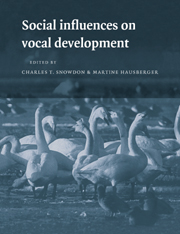Book contents
- Frontmatter
- Contents
- List of contributor
- 1 Introduction
- 2 Social interaction and sensitive phases for song learning: A critical review
- 3 Social interaction and vocal development in birds
- 4 Building a social agenda for the study of bird song
- 5 Field observations, experimental design, and the time and place of learning bird songs
- 6 Vocal learning in wild and domesticated zebra finches: Signature cues for kin recognition or epiphenomena?
- 7 What birds with complex social relationships can tell us about vocal learning: Vocal sharing in avian groups
- 8 Social influences on song acquisition and sharing in the European starling (Sturnus vulgaris)
- 9 Social influences on the acquisition of human-based codes in parrots and nonhuman primates
- 10 Vocal learning in captive bottlenose dolphins: A comparison with humans and nonhuman animals
- 11 Vocal learning in cetaceans
- 12 Social influences on vocal development in New World primates
- 13 Some general features of vocal development in nonhuman primates
- 14 Social influences on vocal learning in human and nonhuman primates
- 15 The resilience of language in humans
- 16 Reciprocal interactions and the development of communication and language between parents and children
- 17 Crafting activities: Building social organization through language in girls' and boys' groups
- Index
13 - Some general features of vocal development in nonhuman primates
Published online by Cambridge University Press: 04 August 2010
- Frontmatter
- Contents
- List of contributor
- 1 Introduction
- 2 Social interaction and sensitive phases for song learning: A critical review
- 3 Social interaction and vocal development in birds
- 4 Building a social agenda for the study of bird song
- 5 Field observations, experimental design, and the time and place of learning bird songs
- 6 Vocal learning in wild and domesticated zebra finches: Signature cues for kin recognition or epiphenomena?
- 7 What birds with complex social relationships can tell us about vocal learning: Vocal sharing in avian groups
- 8 Social influences on song acquisition and sharing in the European starling (Sturnus vulgaris)
- 9 Social influences on the acquisition of human-based codes in parrots and nonhuman primates
- 10 Vocal learning in captive bottlenose dolphins: A comparison with humans and nonhuman animals
- 11 Vocal learning in cetaceans
- 12 Social influences on vocal development in New World primates
- 13 Some general features of vocal development in nonhuman primates
- 14 Social influences on vocal learning in human and nonhuman primates
- 15 The resilience of language in humans
- 16 Reciprocal interactions and the development of communication and language between parents and children
- 17 Crafting activities: Building social organization through language in girls' and boys' groups
- Index
Summary
INTRODUCTION
Striking parallels exist between the development of speech in human infants and the development of song in birds. Many sparrows, for example, learn their songs more readily during a sensitive period than at other times during development, require practice, and must hear themselves sing for normal song to develop (Baptista & Petrinovich 1986). These same features characterize both the earliest speech of human infants (see e.g., Ferguson et al. 1992) and second language learning, whether spoken or signed, among older individuals (Johnson & Newport 1989). Song production in zebra finches and canaries, like speech production in humans, is under lateralized neural control (Arnold & Bottjer 1985; Nottebohm 1991). Damage to any one of these areas, like damage to Broca's or Wernicke's area in (usually) the left temporal cortex of the human brain (for reviews, see Caplan 1987, 1992), produces highly specific deficits in the production or processing of communicative sounds.
As a result of these parallels in both behavior and neurobiology, studies of avian song development currently provide the best animal model for research on the mechanisms underlying speech development (Marler 1987). In contrast, while nonhuman primates are our closest living relatives and have often been used as animal models for the study of human social development (see e.g., Hinde 1984), their vocal communication is generally thought to provide no useful parallels with the development of human speech.
- Type
- Chapter
- Information
- Social Influences on Vocal Development , pp. 249 - 273Publisher: Cambridge University PressPrint publication year: 1997
- 84
- Cited by

